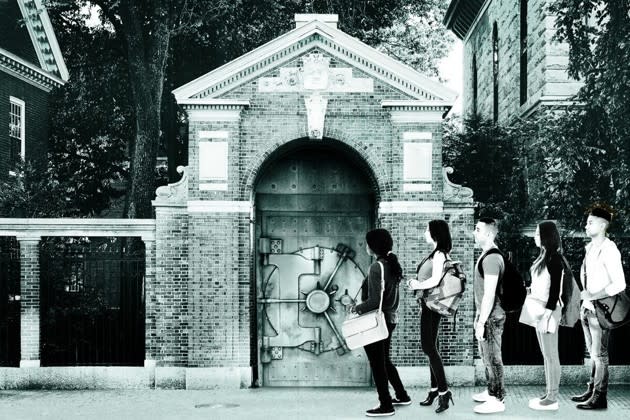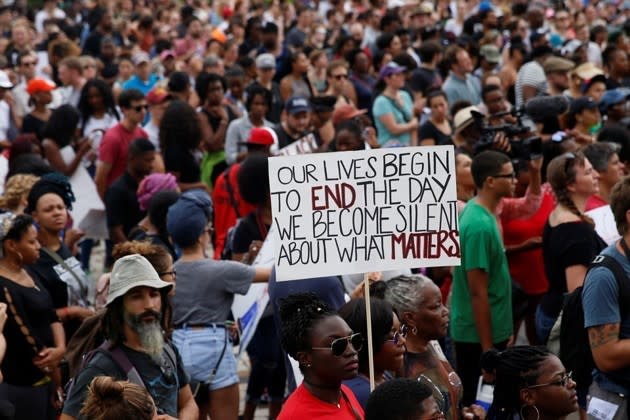Sixteen in ‘16: Our Favorite Education Stories
From Alia Wong
The Absurdity of College Admissions

Acceptance rates at highly selective colleges have plummeted in recent years. Exclusivity has always been baked into their brand: Only about 3 percent of 18-year-olds in the U.S. go to schools that admit fewer than half their applicants, making the “college-admissions mania,” as The Atlantic’s Derek Thompson once put it, “a crisis for the 3 percent.” Still, it’s a mania to which more and more teens are subjecting themselves, pressuring applicants to pad their resumés and tout superficial experiences and hobbies, convincing them that attending a prestigious school is paramount. And critics say that mania has even spread into and shaped American culture, often distorting kids’ (and parents’) values, perpetuating economic inequality, and perverting the role of higher education in society as a whole.
Recommended: My President Was Black
* * *
Although Brown v. Board of Education decided more than six decades ago that segregation in public schools was unconstitutional, children today are more racially and socioeconomically isolated than they have been in decades. Critics often attribute that regression in part to the failure of policymakers to take action—policymakers like [former Education Secretary Arne] Duncan, who in a high-profile episode of This American Life last August acknowledged, “We haven’t done enough.” [Education Secretary John] King wants to change that: “We must find ways to make our schools better reflections of the diverse society we have become.”
* * *
Asian Americans and the Future of Affirmative Action
It’s sad that this is what elite-college admissions have come to: a soul-deadening process that encourages students to distort their identities solely for the sake of getting in. But the rampant racism to which these pointers allude, if real, is even sadder. According to some activists, brilliant, accomplished, and well-rounded Asian students are consigned to gaming a system that’s rigged against them. Either that, or they have to prove themselves extra brilliant, extra accomplished, and extra well-rounded to ensure they’re on equal footing with non-Asian applicants. The premise is that affirmative action enables colleges and universities to discriminate against Asian applicants simply because there are so many of them on campus already.
Recommended: Donald Trump's War on Celebrities
* * *
Today, more than 1 million students are trapped in an education system that wasn’t built for them. That system wasn’t designed to accommodate their disabilities—the kinds of intellectual, cognitive, communicative, and physical conditions that often conjure images of people reliant on wheelchairs and aides, of individuals consigned to dreary, isolated lives. Many of the public schools they attend rest on the assumption that those stereotypes are inevitable truths.
But these students, even those with the most severe disabilities, have potential far beyond what they are often educated for.
From Emily DeRuy
Across the Border and Into School

In the past several years, more than 100,000 children from Central America have fled the violence and poverty of their home countries to travel north—often all alone—for the chance at a better life in the United States. …
Recommended: How Obama Failed Black Americans
As with most young people, school is the daily constant that anchors their lives. For many of these undocumented children, their waking hours are spent mostly in classrooms, where they are attempting to navigate a completely foreign education system. The law is clear: All children in the United States, regardless of immigration status, have the right to a quality public-school education.
* * *
Judge’s Football Team Loses, Juvenile Sentences Go Up
Kids who are sentenced by college-football-loving judges who are disappointed after unexpected team losses are finding themselves behind bars for longer than kids who are sentenced after wins or predicted losses.
That’s the gist of a new working paper by a pair of economists at Louisiana State University. It sounds almost comical, like an Onion headline, at first glance: “Judge Sentences Teen to Two Years After Louisiana Tigers Fall to Wisconsin Badgers.” But, insists Naci Mocan, an economics professor at LSU and a co-author (with a fellow professor, Ozkan Eren) of “Emotional Judges and Unlucky Juveniles,” it’s not far off.
* * *
The Tricky Pursuit of Diversity at the Air Force Academy
Educators and military officials are grappling with shifting demographics, where the people in leadership roles look less and less like the people they are charged with serving. At colleges across the country, the overwhelming whiteness of those in power has prompted Black Lives Matter activists to call for more diversity. At the Pentagon, the Defense Department is looking for creative ways to fight an enemy that is less predictable and more amorphous. Both tasks require a delicate balance of preservation and evolution, of security and openness.
As the leader of both an elite institution of higher learning and a key piece of the military pipeline, [Lieutenant General Michelle] Johnson, [the superintendent of the U.S. Air Force Academy,] sits at the nexus. “We’re trying to deliver this traditional mission in a relevant way to this generation and to the profession of arms,” she said.
* * *
A Plan to Teach Every Child Computer Science
And after more than a year of work, a carefully crafted yet adaptable framework for what computer-science education should look like at each grade level went live this week. The writers hope it will help more states craft standards and ultimately bring the subject to classrooms across the country.
The K-12 Computer Science Framework is a “response to the history of inequity in computer science,” said Pat Yongpradit, the chief academic officer at Code.org, one of the organizations steering the initiative.
From Hayley Glatter
Should Students Learn About Black Lives Matter in School?

If the Chicago social-studies teacher Gregory Michie waits for a textbook to teach his students about the Black Lives Matter movement, the first seventh-graders to hear the lesson won’t be born for another seven years.
Despite the historical implications of that movement, bureaucratic timelines all but quash any possibility that students might learn about today’s events from an actual history textbook in the near future.
The Gendered Past of Typing Education
Over time, typing education has evolved in tandem with both the progression of computer technology and the decreasing age at which students are exposed to that technology. Today, that age may be reaching its lowest limit, as standardized tests and metrics emphasize the need for exceedingly young learners to successfully navigate a computer.
These histories, Darren Wershler, the author of The Iron Whim: A Fragmented History of Typewriting, said, are inseparable from the history of writing itself.
* * *
According to the National Science Foundation, there was a 6.4 percent increase in the number of women intending to major in science and engineering fields between 1995 and 2012. On top of that, the National Panhellenic Council reports its undergraduate membership was 58 percent higher in 2015 than it was in 2007. And so it follows that as women become more likely to study STEM-related fields, so too are women who decide to “go Greek.”
And yet, even as presumably more and more women are balancing what it means to be both technically minded and involved in Greek life, the stigmas associated with sororities continue to range from the foolishly feminine to the flagrant.
* * *
Where Do Schools Close Most Often for Weather?
The frequency with which some districts around the country cancel classes warrants a closer look at closure policies. Districts have their own sets of guidelines for determining when the weather is too difficult to overcome, and while each area deals with specific forecasts and challenges, the variance between states is stark.
Many districts outline on their websites that a primary priority when considering a weather-based closure is the safety of students and faculty, but the ramifications of an unplanned day off extend past chilly toes and spilled cocoa.
From our contributors
Why Do Colleges Have So Much Art?
Jacoba Urist

Public or private, rural or urban, college museums are tackling ambitious projects like never before, promoting academic curators—who were once part of a sleepier, insular art world—to be lead actors on the cultural stage.
But not everyone agrees that school museums should compete with their mainstream counterparts or that students necessarily benefit more from having art of such magnitude as opposed to more modest collections. The ongoing art wave raises questions about whether college museums have outlived their primary purpose as educational institutions and perhaps now serve a different function in both academic and art circles.
* * *
The Unmanufactured Impact of a Plastic Best Friend
Erik Raschke
For an autistic mind, a question is vastly different than it would be for a non-autistic mind. “Are you my best friend?” is more philosophical than literal, an abstract pondering, an eccentric artist examining an established truth.
My son is 10 years old, but he does not know how old he is. He does not know which country we live in. He cannot tie his shoes, brush his teeth, count higher than four. Only within the last month has he begun to remember his last name. Still, ever since he was first diagnosed with his neurodevelopmental condition at the age of 3, I have always recognized the tenebrous clues of consciousness glowing behind his eyes.
* * *
Melissa Scholes Young
Writing centers and campus counselors and diversity-inclusion programs want students to succeed. But as a first-generation college student I avoided all of them, assuming I couldn’t afford the extra bill. Now, as college faculty, I want my students to know what I didn’t.
According to College Board, more than 30 percent of today’s undergraduate students are the first in their families to go to college. Two-thirds of first-generation students attend community college, many part-time. They are disproportionately minorities from low-income backgrounds. And even for those of us who win the elusive admission ticket, three out of five won’t graduate with a bachelor’s degree. Very few of us attend graduate school.
* * *
Black History Month in Schools—Retire or Reboot?
Melinda Anderson
First celebrated in 1976, Black History Month was the result of a growing racial pride and consciousness of black Americans and Woodson’s association pushing to expand the weekly celebration. Now a well-entrenched, nationally recognized observance, Black History Month is a commemoration that might be short in days but is increasingly long on controversy. In the last month—in examples that cross racial boundaries—the black actress and conservative commentator Stacey Dash called to eliminate Black History Month, labeling it a vestige of segregation, while Republicans in the Kansas legislature questioned if an entire month dedicated to honoring black history was “too long.”
And be sure to check out our Educational Eden project. We asked teachers, parents, scholars, and other experts to describe the ideal school system.
Read more from The Atlantic:
This article was originally published on The Atlantic.
